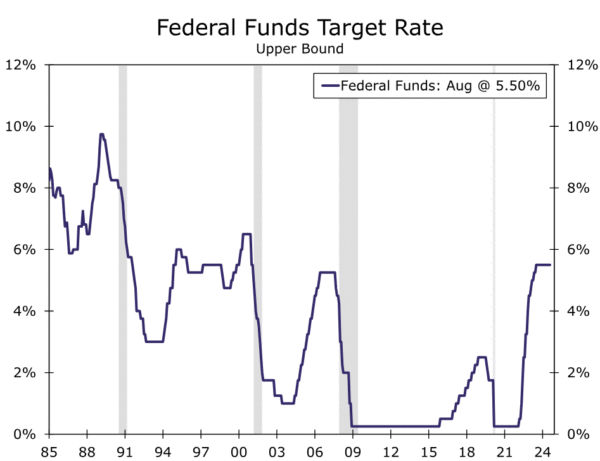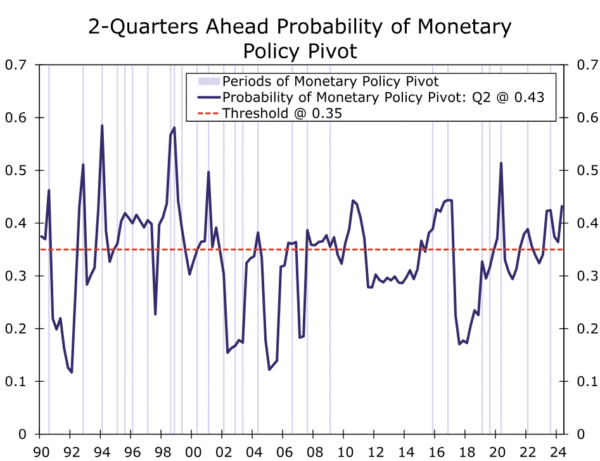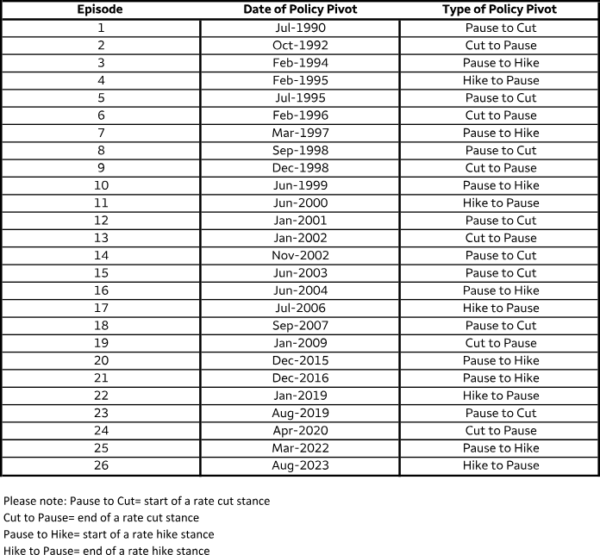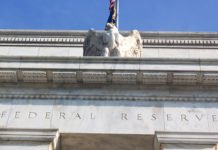Part IV: A New Framework to Predict Probability of Monetary Policy Pivots
Summary
- The fourth installment of this series develops a new framework to quantify episodes of monetary policy pivots.
- We also present a probit regression to predict the probability of a policy pivot during the next two quarters.
- In our view, accurately predicting periods of monetary policy pivots is vital, as a rate cut that comes too late or too soon would be harmful to the economy and damage the FOMC’s reputation.
- Our framework estimated that there are 26 episodes of policy pivots in the post-1990 period.
- Using a threshold of 35%, the probit framework accurately predicted episodes of policy pivots in the post-1990 era.
- The latest probability (Q2-2024) of 43% indicates that a rate cut cycle may start soon (within the next two quarters).
- Given the historical accuracy of our framework, we believe the toolkit would provide useful insights for decision makers, as it can be updated in real time to gauge the likely duration of the upcoming easing cycle.
- We believe accurately predicting the near-term path of the fed funds rate is vital for effective policymaking as well as policy communication. The next installment of the series will present a new approach to predict the fed funds rate two quarters out (up to four FOMC meetings ahead).
Why Is Accurately Predicting Monetary Policy Pivots Important?
Part three of the series presented four-quarters-out probabilities of the three growth scenarios of soft-landing, stagflation and recession. This installment develops a framework to employ those probabilities to predict monetary policy decisions. We follow two different paths to gauge the usefulness of our toolkit. The first method predicts monetary policy pivots, and the second approach forecasts the near-term level of the fed funds rate (a topic we’ll cover in the next installment).
We believe accurately predicting the timing of a policy pivot compliments the generation of the future potential path of the fed funds rate. By predicting the timing of a policy pivot, decision makers could anticipate the potential duration of the current stance, at least in theory. The prediction for the fed funds rate would shed light on how many rate cuts (a relevant discussion for the current cycle) are appropriate in the near future.
In our view, accurately predicting periods of monetary policy pivots is vital, as a rate cut that comes too late or too soon (a widely discussed topic in the present cycle) would be harmful to the economy and damage the FOMC’s reputation. Members of the FOMC have repeatedly acknowledged that their goal is to avoid a mistimed rate cut, whether it be too soon or too late. Some analysts suggested the March 2022 rate hike was too late, as the FOMC misjudged higher inflation as “transitory” and waited too long to act. By the same token, significant changes in the FOMC’s SEP (June 2023 vs. June 2024) made some analysts worry that the next policy pivot (which is expected to be a rate cut) may be mistimed as well.
A New Framework To Quantify Episodes of Monetary Policy Pivots
We develop a new framework to quantify episodes of monetary policy pivots and present a probit regression to predict the probability of a policy pivot during the next two quarters. At present, the FOMC regularly meets eight times a year, with four meetings in the first half and four in the second half. Thereby, we set a two-quarters-out forecast horizon to predict the chances of a policy pivot during the next four meetings. Given the volatile nature of the economy during the post-pandemic era, a one-year-out prediction for a policy pivot would suffer lower accuracy, as the rapidly changing nature of potential risks would dictate a faster response from the FOMC, all else equal.
We define a policy pivot as a change in the FOMC’s rate decision compared to the past few meetings. There are two key elements in our definition of a policy pivot. The first is that the FOMC has a different rate decision than the past few meetings. The second condition is that the FOMC keep the stance for the next few meetings, at least. There are three rate decisions that have been utilized by the FOMC, at least in the post-1990 era. The FOMC either (a) raises the target of the fed funds rate, (b) keeps the rate unchanged or (c) reduces the rate (Figure 1).
Historically, once the FOMC adopts a policy stance (a rate hiking stance, for example), it keeps that stance for at least several meetings. In the post-1990 era, the shortest duration of a policy stance was about six months, which occurred in 1995. The FOMC raised the fed funds rate to 6.00% from 5.50% in February 1995, and then kept that rate (a rate pause) until its June meeting. The FOMC reduced the rate by 25 bps in July 1995.
We use these conditions to identify periods of policy pivots. The last policy pivot date was in August 2023, as that was the first month after the fed funds rate peaked at 5.50% in July 2023. After 13 consecutive months, the fed funds rate is still at 5.50%. Essentially, August 2023 marks the end of the rate hike stance that started in March 2022. If the FOMC cuts rates in September 2024, then that would be the next policy pivot, as it would be the start of a rate-cut cycle (a policy normalization stance). Of course, this is assuming the FOMC will adopt a rate-cut stance for the near future.
Episodes of the Monetary Policy Pivot in the Post-1990 Era
Our framework estimated that there are 26 episodes of policy pivots in the post-1990 period (for detail see Table 1). We concentrated on the post-1990 era, where the FOMC’s communications about policy decisions are more transparent and shared with the public in a timely matter. One example of the FOMC’s communications can be seen in the fed funds rate series, as the post-1990 data are smoother, and policy stances (from rate cuts to policy pauses, for example) can be identified with a reasonable confidence. (Figure 1)
By our definition, there are four types of policy pivots: (1) pause-to-cut, which is the start of a rate-cut stance, (2) cut-to-pause, which is the end of a rate-cut stance, (3) pause-to-hike, which is the start of a rate-hike stance and (4) hike-to-pause, which is the end of a rate-hike stance. There are eight episodes of pause-to-cut, six of cut-to-pause, seven of pause-to-hike and five of hike-to-pause. Most policy pivots in the post-1990 era included a pause stance (11 pivots are either cut-to-pause or hike-to-pause), while eight took an easing/rate-cut stance and seven took a tightening/rate-hike stance. Our forecast horizon is only two quarters out, therefore the type of policy pivot would be known to a forecaster. Thus, we only concentrate on predicting the timing of a policy pivot.
A Probit Approach To Predict the Probability of Monetary Policy Pivots
The major benefit of identifying periods of policy pivots is that we can build a regression to generate the probability of a policy pivot in the near future. For example, we identifed 26 episodes of policy pivots in the 1990-2024:Q2 period, and then we created a dummy variable where a value of one represents a pivot occurring and zero is otherwise. Using the dummy variable, a probit regression is developed to predict the two-quarters-out probability of a policy pivot. Part III of the series presented four-quarters-out probabilities of the three growth scenarios of soft-landing, stagflation and recession. We employ those probabilities as predictors of the probit regression.
Figure 2 shows the two-quarter-out probability of a policy pivot, and the bars represent actual periods of policy pivots (based on our framework; see Table 1 for detail about those pivots). Using the average probability of 35% as a threshold (dotted line in Figure 2), the framework accurately predicted all episodes of policy pivots in the post-1990 era.
As seen in Figure 2, the probability of a policy pivot started trending upward in Q2-2021 and breached the threshold in Q3-2021. The framework suggested starting a rate hike cycle sooner than Q1-2022, with a possibility of a rate hike in 2021. Neither the FOMC nor the Blue Chip consensus provide an explicit probability of a policy pivot, but the FOMC’s SEP and the Blue Chip consensus did not predict a rate hike in 2021 (i.e., no policy pivot in 2021). However, both forecasts did predict rate hikes in 2022. In retrospect, our framework would have helped decision makers determine appropriate timing for the rate-hike cycle back in 2021-2022.
The policy pivot probability jumped in Q2-2023 (from 34% to 42%), and then peaked in Q3-2023, which is consistent with the most recent policy pivot of Q3-2023—a hike-to-pause pivot. Q4-2023 and Q1-2024 noted a declining trend (but still above the threshold line) which may have cautioned analysts that a policy pivot to rate cuts were potentially further away. The latest probability (Q2-2024) of 43% indicates that a rate cut cycle may start soon (within the next two quarters), which is consistent with financial markets participants’ expectations for the upcoming September FOMC meeting. Given the historical accuracy of our framework, we believe the toolkit would provide useful insights for decision makers, as it can be updated in real time to gauge the likely duration of the upcoming easing cycle.
A Policy Pivot Is Most Likely, but What About the Pace/Duration of the Easing Cycle?
In summary, the latest probability (Q2-2024) of 43% indicates that a rate cut cycle may start soon (within the next two quarters), which is consistent with both the FOMC and Blue Chip forecasts, as they are also predicting a policy pivot in 2024.
FOMC members provide their near-term (as well as long-run) fed funds rate forecast. The June 2024 SEP suggests one 25 bps rate cut in 2024 and four more cuts throughout 2025. The FOMC employs its fed funds forecast (along with their other forecasts) to signal its near-term policy stance. In the short run, significant changes in the forecast would send undesirable signals and raise questions about the accuracy of the fed funds forecast. Therefore, in our view, accurately predicting the near-term path of the fed funds rate is vital for effective policymaking as well as policy communication. The next installment of the series will present a new approach to predict the fed funds rate two-quarters-out (up to four FOMC meetings ahead).
Table 1
Source: Federal Reserve Board and Wells Fargo Economics
















